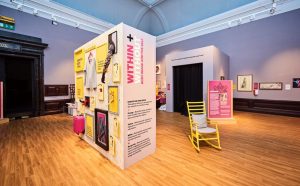The BMAGs new exhibition, ‘Within and Without: Body Image and the Self’ which is open from now until the 1st February 2018, is an intriguing exhibition that looks at the ideals, anxieties, stereotypes, and practices that surround beauty. Importantly, it reflects on the ideal body seen in public and digital spaces, and the displays consequently explore how body image as an issue collides with race, gender, sexuality, health, politics, social status, and religion. It asks the question, inscribed on an exhibition wall, “where do standards of health and beauty come from?”

In an effort to answer this question, this exhibition was envisioned as a testing and collaborative space, working with over 70 volunteers, which included the Lordswood Girls School students, the Birmingham LGBTQ+ Refugee Group and an over 50s group, alongside the curatorial and engagement teams. This diversity of involvement is reflected in the themes explored in the exhibition, to address the impact of the beauty ideal across a spectrum of lived experiences.
In conversation with Professor Heather Widdows
To coincide with the exhibition and this question, BMAG hosted an informal talk with Professor Heather Widdows from the University of Birmingham on Tuesday the 4th September. Heather is the John Ferguson Professor of Global Ethics, where her current research explores the ethical and moral nature of beauty, and its increasing demands. This research has resulted in the book Perfect Me: Beauty as an Ethical Ideal, published this year.
In her defining of the beauty ideal, especially in the global sense, Heather outlined four key attributes: thinness, firmness, smoothness, and youth. This is the range within you must fall in order to meet the criteria of ‘beautiful’. But they are also tradable commodities. You can be beautiful if you’re big as long as you’re young and smooth and firm. You can be beautiful at an older age, as long as you’re thin and smooth and firm.
One of the themes that emerged from this talk was the moralistic and aspirational drive behind the beauty ideal that is reflected on how we view our worth and our self. The self has become tied to the physical body and its appearance, our worth measured by our physical successes. It is reflected in how much we adhere to the beauty ideals of thinness, firmness, smoothness, and youth. This results in the now normalised assumption that an improvement in the body is an improvement in the self, which can be seen in the most common New Year’s Resolutions. With the rise of visual and selfie culture, this has resulted in ‘the best selfie is the best self’, to quote Heather. But this impacts us negatively, with the result being an ‘epidemic of beauty image anxiety’: feelings of shame and disgust become entrenched and failure in meeting beauty standards means a failure of the self.
With the globalisation, normalisation, and naturalisation of the beauty ideal as an ethical ideal, beauty rituals have transformed into health or hygiene practices. Hair removal is an example of a practice that currently straddles the line between beauty and hygiene, and reflects the beauty ideal of smoothness.
Once normalised, it becomes invisible. So what is Heather’s solution? First and foremost, we should not blame the individual and how they respond to the pressure of trying to attain this beauty ideal and therefore the promise of their best self. This is a pointless critical debate that often harms the more vulnerable and fails to create positive change.
We should, however, criticise shaming talk, as this is integral to the nature of the culture, not the individual. We do not consciously choose our beauty ideals, embedded as they are within sociocultural environment, but we can choose how we conform. By being more forgiving of ourselves and other individuals, and by recognising the dominant norms, we alleviate the pressure to adhere to this now naturalised beauty ideal.
Finally, Heather argues that through shared, social, and communal interactions can these norms be rendered visible and thus deconstructed. The ethical and moralistic nature of beauty, when packaged as a choice or as superficial, makes it more insidious. The problems of beauty image anxiety should be a public health concern.
In light of this talk, exhibitions such as BMAGs ‘Within and Without’ are incredibly important. They are integral to this shared and social aspect, making the invisible expectations visible. They help us navigate the visual expectations and norms of our culture. By representing bodies that are not usually available in mainstream media, BMAG has delivered an incredibly important and socially critical exhibition that will hopefully encourage the Birmingham public to think about “where do standards of health and beauty come from?”

Gallery 15 or the Story LAB, where the exhibition is held, also acts as a space to test storyline and engagement methodologies. This gallery space is currently part of a case study to help the museum investigate museum labels and what appeals most to the public: the personal, academic, or object description label. Please let the museum know which label you most prefer.
Admission to ‘Within and Without: Body Image and the Self’ is FREE.

1 thought on “‘Within and Without’: reflections on the body and the self”